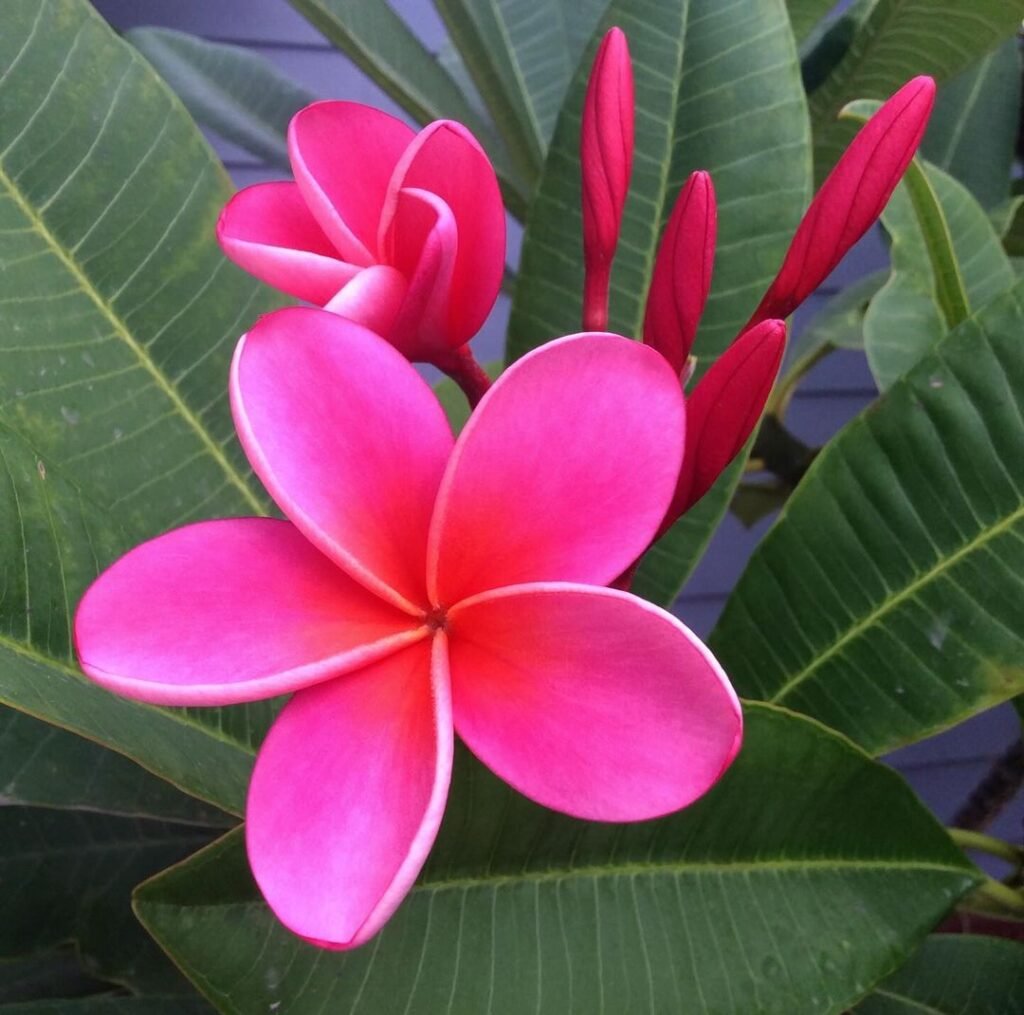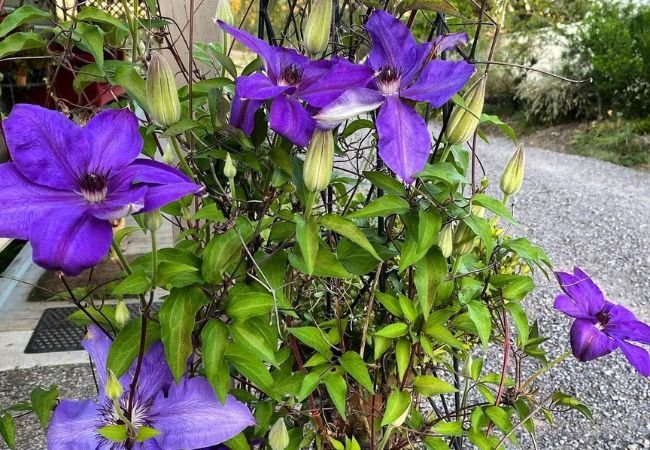Discover how to grow and care for Pink Plumeria, a stunning tropical flower with vibrant pink petals. Get essential tips on planting, maintenance and enjoying these fragrant blooms in your garden.
Pink Plumeria, also known as Frangipani, is a stunning tropical flower that can bring a touch of paradise to your garden. With its vibrant pink petals and sweet fragrance, this plant is a favorite among gardeners and flower enthusiasts. In this guide, we’ll explore everything you need to know about growing and caring for Pink Plumeria.
Here’s an easy-to-read chart for Pink Plumeria:
| Category | Details |
|---|---|
| Botanical Name | Plumeria rubra ‘Pink’ |
| Common Name | Pink Plumeria, Frangipani |
| Plant Type | Tropical deciduous shrub/tree |
| Hardiness Zone | 9 to 11 (USDA) |
| Sun Exposure | Full sun |
| Soil Type | Well-drained, sandy or loamy |
| Watering | Moderate; drought-tolerant once established |
| Growth Habit | Rounded, spreading |
| Height/Spread | 3 to 10 feet (1 to 3 meters) tall; 3 to 8 feet (1 to 2.5 meters) wide |
| Special Features | Fragrant flowers, attracts pollinators, and has a distinctive, exotic appearance |
What is Pink Plumeria?

Plumeria rubra, commonly known as Pink Plumeria, is a species of flowering plant in the dogbane family, Apocynaceae. It’s native to Mexico, Central America, and the Caribbean, but is widely cultivated in tropical and subtropical regions worldwide.
Key features of Pink Plumeria include:
- Fragrant, pink flowers with yellow centers
- Leathery, elongated leaves
- A tree-like or shrub-like growth habit
- Blooms primarily in summer and fall
Pink Plumeria is often associated with Hawaiian leis, making it a symbol of tropical beauty and relaxation.
Growing Pink Plumeria
Climate and Hardiness
Pink Plumeria thrives in:
- USDA hardiness zones 10-12
- Tropical and subtropical climates
- Areas with warm temperatures year-round
In cooler regions, Pink Plumeria can be grown in containers and moved indoors during winter.
Sunlight Requirements
For optimal growth and blooming, Pink Plumeria needs:
- Full sun (6-8 hours of direct sunlight daily)
- Protection from intense afternoon sun in very hot climates
Soil Preferences
Pink Plumeria prefers:
- Well-draining soil
- Slightly acidic to neutral pH (6.0-7.0)
- A mix of potting soil, perlite, and sand for container growing
Watering Needs
Proper watering is crucial for Pink Plumeria:
- Water deeply but infrequently
- Allow soil to dry between waterings
- Reduce watering in winter when the plant is dormant
Overwatering can lead to root rot, a common problem in Plumeria cultivation.
Fertilizing
To promote healthy growth and abundant blooms:
- Feed with a high-phosphorus fertilizer during the growing season
- Apply fertilizer every 2-3 weeks from spring to fall
- Reduce or stop fertilizing in winter
Pruning and Maintenance
Regular pruning helps maintain the shape and health of your Pink Plumeria:
- Prune in late winter or early spring before new growth begins
- Remove dead, diseased, or crossing branches
- Trim to control size and shape as desired
Propagation
Pink Plumeria is relatively easy to propagate:
- Take cuttings in spring or summer
- Allow cuttings to dry and callous for a few days
- Plant in well-draining soil and keep warm and slightly moist
Common Problems and Solutions
While Pink Plumeria is generally hardy, it can face some issues:
Pests
- Spider Mites
- Symptoms: Fine webbing on leaves, yellowing foliage
- Solution: Spray with neem oil or insecticidal soap
- Mealybugs
- Symptoms: White, cottony masses on stems and leaves
- Solution: Remove with cotton swabs dipped in rubbing alcohol
Diseases
- Root Rot
- Symptoms: Wilting, yellowing leaves, soft, brown roots
- Solution: Improve drainage, reduce watering, and repot if necessary
- Plumeria Rust
- Symptoms: Orange or brown pustules on leaves
- Solution: Remove affected leaves, improve air circulation, and apply fungicide if severe
Enjoying Pink Plumeria Blooms
Pink Plumeria flowers are not only beautiful in the garden but also make excellent cut flowers:
- Cut flowers in the morning when they’re freshly opened
- Place stems in warm water immediately after cutting
- Change water daily to extend vase life
The sweet fragrance of Pink Plumeria can fill a room, making them perfect for indoor arrangements.
Pink Plumeria in Landscape Design
Incorporate Pink Plumeria into your garden design:
- As a focal point in tropical-themed gardens
- In container gardens on patios or balconies
- Near outdoor seating areas to enjoy their fragrance
- Paired with other tropical plants like hibiscus or bird of paradise
Winter Care for Pink Plumeria
In colder regions, Pink Plumeria needs protection during winter:
- Move container plants indoors before temperatures drop below 50°F (10°C)
- Reduce watering and stop fertilizing during dormancy
- Provide bright, indirect light indoors
- Resume normal care when temperatures warm up in spring
Cultural Significance of Pink Plumeria
Pink Plumeria holds special meaning in many cultures:
- In Hawaii, it’s used in leis to welcome visitors
- In Hindu culture, it’s associated with devotion and loyalty
- In Mayan culture, it was believed to have medicinal properties
Understanding these cultural connections can add depth to your appreciation of this beautiful flower.
Growing Pink Plumeria can bring a touch of tropical paradise to your garden. With their vibrant pink blooms and sweet fragrance, these flowers are sure to become a favorite. Remember to provide them with plenty of sunlight, well-draining soil, and proper watering to ensure healthy growth and abundant blooms.
Whether you’re growing Pink Plumeria in a tropical climate or nurturing them in containers in cooler regions, these stunning flowers are worth the effort. Their beauty and fragrance will transport you to a tropical oasis, right in your own backyard.
By following the tips and care instructions in this guide, you’ll be well on your way to enjoying the lush, pink blooms of Plumeria in your garden. Happy growing!
For more gardening tips and plant care guides, visit usagardenhub.com







One comment on “Pink Plumeria : Tips for Growing and Caring for These Tropical Blooms”